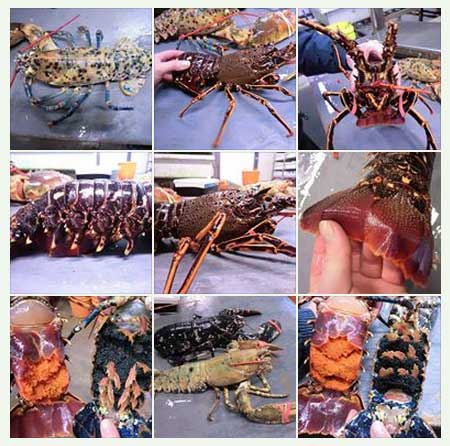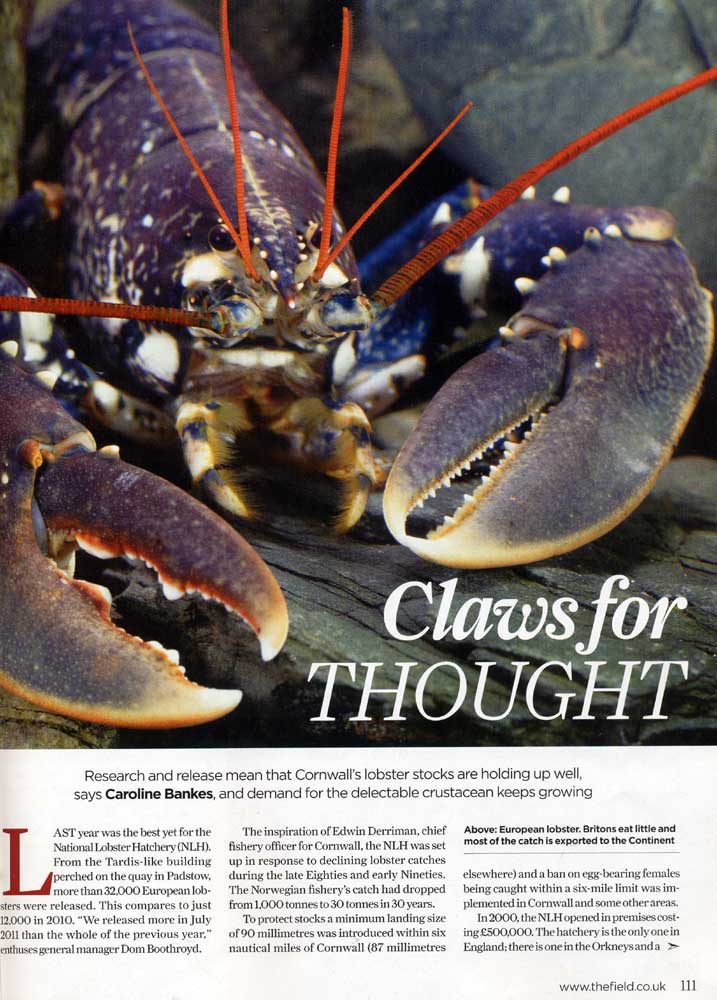

 |
The
Lobster is the largest and strongest of our native crustaceans. Undisturbed,
its life span may reach 15 years, or more. When caught in pots, the usual
size is from between 23 and 38 cm (9 - 15 in), weighing between
0.7 and 2.2 kg (1.5 - 5 lb). The legal measurement is the carapace
only. The minimum legal size (in Sussex waters) is 85 mm (3.5 inches,
carapace length). The length excludes the claws and telson (tail) so the
lobster appears much larger.
Lobster fishing is strictly controlled with a licence needed if you capture more than two specimens in one day.European Lobster
NEWS:
August
2016
A
huge 7.65kg (17 lb) European
Lobster,
Homarus gammarus (= H. vulgaris),
was captured by free diver Joe Pike
off Lannacombe
Beach, south Devon. It was captured and taken to the National
Aquarium at Plymouth for further captive
study. It is the second largest European
Lobster on record as a confirmed weight although
from the size and weights of remains, even larger Lobsters
could be extant.
American
Lobster
Marine
Management Organisation
Image
A small number of fishermen on the Sussex coast are reporting catches of non-native American Lobster, Homarus americanus, and Dungeness Crabs, Metacarcinus magister, in an area in the vicinity of Brighton on the Sussex coast.
Captures should be retained and it is illegal to return non-native species to the sea. Report finds to to IFCA or the MMO.
This crab was caught in nets off Brighton by George Sutton, who also caught an American Lobster on 19 June 2015.
March
2014
Two
large
 |
15
December 2013
Leucistic Lobsters and Spiny lobster/Crayfish/Crawfish, Palinurus elephas, housed in a commercial holding aquarium at Cushendall, County Antrim. These larger than normal Lobsters (> 2 kg) were caught around Rathlin Island, (north of Ballycastle) Northern Ireland. |
 |
 |
Field magazine for August 2012 has got a feature on Lobsters and one on beach Shrimping as well. Available in the larger branches of WH Smith on the shelf from the end of July 2012. Recommended light reading. £4.20. |
The largest
European
Lobster, Homarus gammarus
(= H. vulgaris), on record measured 1.26 metres and weighed 9.3
kg (20 lb 8 oz). It was caught during reconstruction
work on a jetty off Fowey in Cornwall as long ago as 1931.
Its crushing claw weighed 1188 g (2 lb 10 oz) after the meat
was removed. Its total length was 1.26 metres.
(Guinness Book of Records
1991)
The length that the European
Lobster will normally grow to if it is not captured is a total length of
50 cm, weighing about 5 kg (11 lb). A lobster of this size may be
20 years old.
A large Lobster at the Shoreham-by-Sea display 1999. Lobsters of this size, nearly 4 kg (9 lb), need to be supported if lifted from the water.
John
Barker captured an exceptional lobster by hand (or rather,
two hands) underneath the Palace Pier at Brighton in 1963
which weighed 3.85 kg (8 lb). It was put on display in the old Brighton
Aquarium.
In the last century, in
1875, a 6.4 kg (14 lb) Lobster was caught in a trammel net off south
Cornwall.
In 1877, a 5.4 kg (12 lb)
Lobster was captured in Saints Bay, Guernsey, Channel Islands.
American Lobsters have been captured off the Devon coast in the first part of 1996. It is thought that they were discarded from the galleys of cruise ships.
Norwegian
Lobsters
The
biggest crushing claw of a lobster ever found was calculated to have been
from a specimen that weighed about 9.3 kg. This claw was trawled up outside
Gilleleje, Denmark in 1974. It was caught in 20 metres of water and the
claw was 364 mm long.
In
March 1988, a European Lobster weighing a record 10 kg (22 lb) was
caught off the west coast of Norway, near Floroe. I have been unable to
find out what happened to this specimen, so there may be some doubt to
the authenticity of this record.
24
August 2012
An
exceptionally large 7 kg (15 lb 4 oz) European
Lobster, Homarus gammarus, was
found by divers, Mark Corp and Mark Reed,
and donated to the Blue
Reef Aquarium at Portsmouth.
It appears to be the heaviest one caught off the British coast since 1931.
 |
 |
 |
Lobster at Adur World Oceans Day 2012
The large 4 kg male European Lobster, Homarus gammarus, on display at Adur World Oceans Day 2012 was put into a large holding tank at Monteums Ltd, Shoreham-by-Sea, for captive study. There is an even larger (but not so heavy) female for a possible mating.
15
December 2009
A
large European Lobster,
Homarus
gammarus (= H. vulgaris), was captured
by Simon Sharp
off Devon and was under a metre long (total length) at 0.96
metres. The sluggish crustacean was returned
to the sea unweighed.
18
June 2006
An
exceptionally large European Lobster,
Homarus
gammarus, was caught by Louie
Smith, aged 16, off Deal
pier in Kent. It weighed 5 kg (11 lb
3 oz).
 22
June 2003
22
June 2003
Looking into the lobster bays is a real education, with about 50% being right handed (the side of the crushing claw) with the rest left handed. Others seem to have a variety of claws that are not easily identified as crushing or cutting, but between the two. Colours vary from almost black to a very light shade of blue with some being pink.from Bob Alexander (Weymouth)
 |
 |
15
May 2011
An unusual orange European Lobster, Homarus gammarus, was caught by a fisherman Steph Noel near Icho Bank, South of St Helier, Jersey, in his pots with the usual blue lobsters.Stephhad only caught three similarly coloured lobsters in 27 years of fishing for them. The lobster was returned to the sea. |
6 October
2006
Fisherman
David
Gillingham caught a rare off-white Lobster,
Homarus
gammarus, in the Swinge between Alderney
and Burhou in the Channel Islands (English Channel). The lobster was white
on its underside with grey-green markings on its back and blue claws which
were not as bright blue as usual. It was flown by air to Guernsey Aquarium
which will be its new home.
July
2005
Fisherman
Lloyd
Turner discovered a rare white Lobster,
Homarus
gammarus, among his catch 12 miles
north-west of Alderney in the English Channel. The Lobster was It
was given to the National
Lobster Hatchery in Padstow, Cornwall.
The unusual lobster was kept alive in his vivier, until put on public display in the Guernsey Public Aquarium on 10 September 2003.
September
2000
I live on the Isle of Man
which is a small Island located in the Irish sea between England and Ireland.
A friend of mine who is a professional fisherman caught a lobster which
is half male and half female. It has 2 distinct colours, one side black,
the other orange. He understands this is very rare and to his knowledge
this is the first time one has been caught in these waters. Could you supply
any details of who would be interested in this ? The lobster is being kept
alive for the moment pending any genuine
interest
Best Regards
Keith (September
2000)
Sender: Contact@openjumbo.com
As head chef of the Kaspia restaurant in London's Mayfair, William Cooper knows a lobster when he sees one but was overawed when he arrived one morning to find a European Lobster, Homarus gammarus, nearly one metre in length sitting in his kitchen! (pic)
This lobster had arrived at the restaurant as part of a regular seacatch delivery from off the Cornish coast and was to be boiled in the pot that afternoon. However, he was saved from this obscenity by Mr. Cooper himself.
Mr.Cooper said, I have seen plenty of Lobsters in my time, but I knew this was special. It was too big and too beautiful to cook. I couldn't bring myself to do anything with it so the only thing I could think of was to call the London Aquarium and see if they could take him in.
On 18 October 2001, this Lobster called "Barney" was released into the Plymouth Sound Marine Conservation Area.
Their research:
The lobster is certainly thought to be the longest in Europe and the second largest in the world at a length of 96 cm. The longest previous recorded Lobster in the world (a North Atlantic Lobster, Homarus americanus) was caught in 1977, measured 106 cm from the end of its tail-fan to the tip of its largest claw and was caught off the coast of Nova Scotia, Canada
 |
 |
June
2002
An
American
Lobster,
Homarus
americanus,
was discovered captured by a fishing vessel on a boat out of Selsey, West
Sussex. A few specimens have been caught before in the approaches to Southampton
Water.
17
March 1995
A
North
American Lobster was brought up in a pot with a European Lobster 30
miles south of the Isle of Wight by a south Devon boat. It was a berried
female and was taken to the Marine Biological
Association at Plymouth where it was been put into quarantine until
the eggs are hatched and it was put on view to the public in their Aquarium
later. The claws are a different shape and reddish on the underside and
the rostrum is rather longer than on the European Lobster.
Cornish
Marine Life Records (Ray Dennis) 1995
NB
March
2005
An American
Lobster from the Maine, USA, was caught with a reported weight
of about 10 kg: Link
TAXONOMY
| Phylum: | Arthropoda |
| Subphylum: | Crustacea |
| Class: | Malacostraca |
| Order: | Pleocyemata |
| Infraorder: | Astacidae |
| Family: | Nephropidae |
| Genus: | Homarus |
Discarded
exoskeletons of the European Lobster (Link)
Padstow Lobster Hatchery
The eggs change colour as they develop, at first they are dark green, then black and finally they begin to turn red as the embryo develops and consumes the yolk to reveal itself though the transparent outer layer. Hatching occurs over several nights in batches of a couple of thousand at a time, when the stage 1 larvae are released into the water column by a shake of the female’s tail and pleopods (=swimmerets), to begin their planktonic stage. Padstow Lobster Hatchery: Biology of the European Lobster
Padstow Lobster Hatchery facebook
|
|
|
|
|
|
Membership Form |
|
Notes:
Reconstruction Work:
Demolition of part of a jetty;
found under a caisson, which is a case for keeping out water while the
foundations of the jetty were being built.